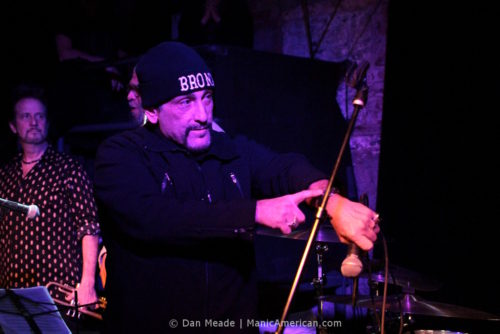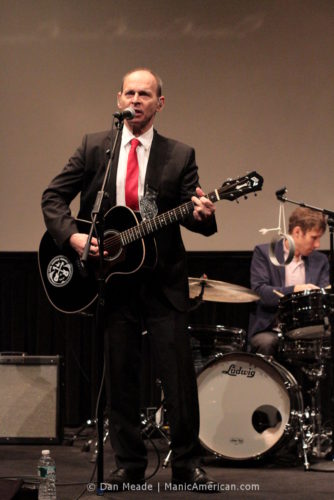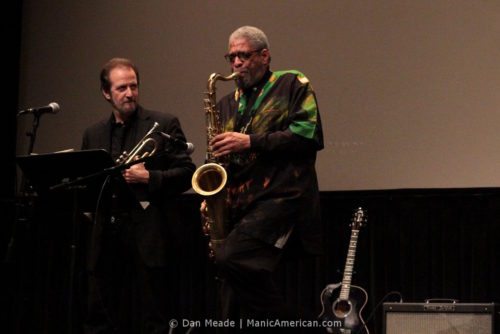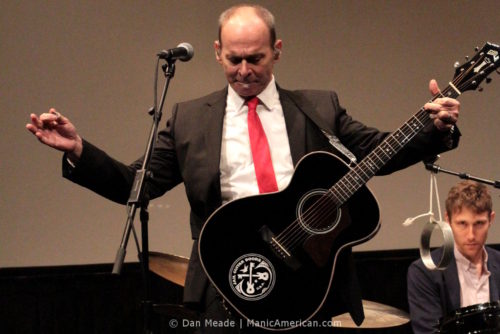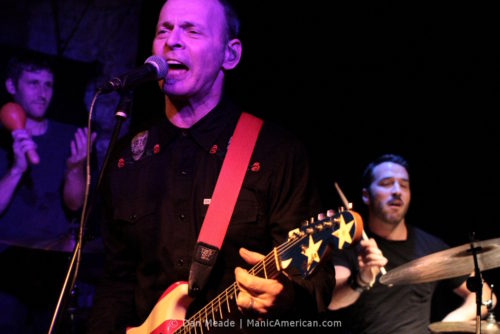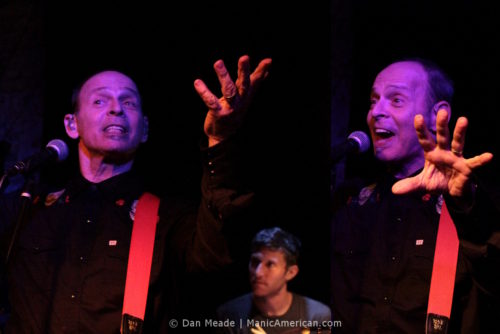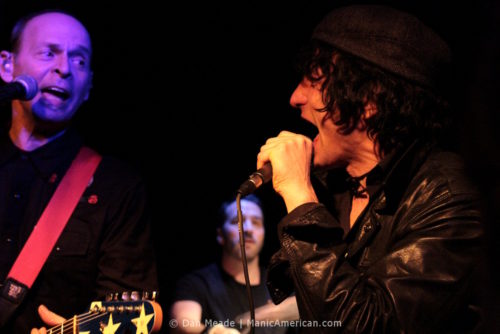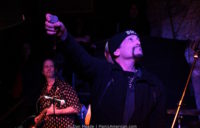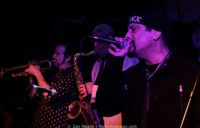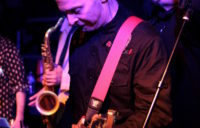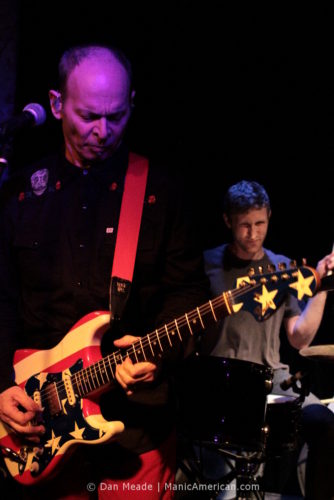It should have been awesome. There should have been an electric buzz in the air. It was the moment that everyone wanted, had been waiting for. Yet, at the end of Wayne Kramer’s first show in New York in ten years, when Handsome Dick Manitoba was asking the crowd, “Do you know what time it is? Do you know what time it is?,” the tension didn’t snap with euphoria when he shouted out, “it’s time to kick out the jams motherfuckas!!!” Instead it felt out of place, and a little disruptive.![]()
Yes, this was the signature song from Wayne Kramer’s days as the guitarist for the MC5. Yes, the MC5 were proto-punk pioneers who helped pave the way for bands from The Ramones to Green Day and beyond. But Wayne Kramer is no longer that man, and his two events in New York were not just another stop on the Old Punks Roadshow. He wasn’t here to celebrate and profit from past glory days, but to be recognized for and to draw attention to his charitable efforts of recent years.
The Angry Young Man
The first of Kramer’s two events in New York was held in the very un-punk Lincoln Center. Past the ballet and opera houses and inside the Walter Reade Theatre was the debut screening of the episode of PBS’ Lifecasters that focused, in part, on Kramer. His section, sandwiched between the stories of a dancer and a composer, starts with Tom Morello and Don Was talking about the MC5, their music and their importance. Morello spoke of how the MC5, more than just being a loud/hard/fast band, were important for being “a decade ahead of The Clash in combining radical music with radical politics.”
As images of a young and wild-haired Kramer flashed across the screen the story of the band was recapped: their rise in Michigan, the ways that the local police watched them due to their anti-establishment and paramilitary aspects, their involvement with the White Panthers, and all the sex, drugs and rock and roll than came with being young and famous. But all that led Kramer to fame also led to him serving four years in prison after a 1975 drug bust.
That time in prison didn’t make Kramer change his ways. He continued living hard and fast for another two decades before he finally suffered a “collapse on the inside.” It was only in 1999 than he realized that he had to change his life around or risk losing it completely.
The Crusader
In 2009 Kramer was playing a benefit concert at Sing Sing prison when he came upon Billy Bragg backstage. In a story that he related multiple times over the course of his two events, Kramer spoke with Bragg about the latter’s work with Jail Guitar Doors, an organization that provided prison inmates in the U.K. with guitars. Bragg said the organization’s name came from “a Clash B-side” and Kramer told him not only had he heard of the song, but that the song was written about him and his own time in jail.
That exchange led to Kramer helming the American branch of Jail Guitar Doors and he speaks of it like a man who has seen the light and is trying to show it to others. When talking of the organization, he says things like “service rebuilds self-respect and integrity,” and that “creativity is a good guard against worthlessness.” He quotes Jesse Jackson’s message that “everybody is somebody.” Self-worth, redemption, release, pride and expression – these are what he is trying to provide America’s inmates with, the guitars are merely the tool with which they can achieve them.
This was best expressed by a scene toward the end of his Lifecasters segment. In it a group of inmates sing “Knockin’ on Heaven’s Door” while Kramer leads another group on guitars. The camera focuses on the men in their orange jumpsuits and shows the emotion of the song playing out on their faces and in their voices – they look more like a group of Hare Krishnas than locked-up criminals. Watching this on screen made for a touching moment, and it provided an image not normally associated with prison life: the healing power of music.
After Lifecasters ended, Kramer appeared on stage to play two songs with his current band. Standing in the center of the stage in a suit and tie, now wiry and balding, this Wayne Kramer looked almost nothing like the Wayne Kramer of the MC5. The first song he played was an acoustic folk/protest song and the second was a sax-and-axe experimental piece. Each revealed that this was still a passionate man who took umbrage with the system and the way things were, but his methods had changed. No longer about sonic fury and social unrest, Kramer was now using his music to get a message across, directly and plainly, putting him more in league with Woody Guthrie than Iggy Pop.
The Showman
The day after the Lifecasters event Kramer played a concert at the Bowery Electric. The Bowery Electric is located just steps from where CBGB’s once stood, and there were plenty of jean jackets full of punk regalia in the crowd, yet there were no signs that this would be a MC5 show. The flyers billed it simply “Wayne Kramer of MC5 returns to the Bowery / Brother Wayne’s first solo NYC show in 10 years!” The image was of Kramer bruised and seemingly about to toss his guitar into a crowd. It was undated but based on the Kramer who spoke at Lincoln Center, it seemed like it was from a lifetime ago.
Once the final opening band cleared the stage – a band, Threats, that played loud, hard and fast and that had more than a faint MC5 echo in their sound – Kramer’s roadies taped down his set list. There were only two MC5 songs on it: “High School” and “Rama Lama Fa Fa Fa.” This seemed fitting as Kramer could not deny his roots but would focus on his new material and interests.
His suit traded for fire engine red pants and a rockabilly style skull-and-roses shirt, Kramer came out and slid right back into his mini-set from Lincoln Center. The night’s first song was the experimental-sounding one from the day before, followed by a song about humans having limited power, but always wanting more. Then he brought the past into the future with “High School.”
Kramer introduced the song by saying that the MC5 had been “an aggressive, anti-establishment band, but I want to show you that we had a sensitive side.” He then took what had been a fast song with a driving rhythm, slowed it down, and turned it into almost a campfire sing-a-long. Arms stretched and smiling, he led the crowd through the chorus, and it was a touching moment. He really did bring out the sensitive side of the song – he may have written the song only a few years removed from high school, but decades later, he found new nostalgia and innocence in the subject matter.
The next four songs were all from his modern oeuvre, including a cover of “Jail Guitar Doors.” These all had the sound of a man angry at the state of affairs, railing against those in power, and seeking change, but who was older now, still with a fiery passion but also the cool resolve of someone who has gotten used to slowly working toward social justice. The songs were like the slow and careful dealings he was filmed making with prison officials in Lifecasters: I have a point, a valid one at that, and if you’ll just listen you can see that it will make things better for all of us.
Kramer hadn’t changed the world with the fury of the MC5, but he was now changing lives with the patience needed to run Jail Guitar Doors. He had changed, evolved even. And yet, when he brought out Jessie Malin and Jeremy Piven for “Jail Guitar Doors” you heard the crowd thrill a little. Kramer said that he didn’t have the ego to sign the first lines of “Doors” himself, but just by being there Malin — well known on the Bowery from his D Generation days — upped the ante for the show. Would there now be other special guests coming? Did Kramer have any other tricks up his sleeve? Would “Rama Lama” really be the only other MC5 song that he played?
As the crowd settled in for the final song, Kramer called out for Manitoba. The former Dictator took center stage and Kramer moved off to the wing as Manitoba launched into his “what time is it” routine. After the opening cry of “Kick Out the Jams” the band delved into the MC5’s best-known song, while Kramer stayed on the wing, letting Manitoba keep center stage. Like hearing Joan Jett sing “I Love Rock and Roll” or Fishbone performing “Party at Ground Zero,” hearing this band of graying musicians play “Jams” was both awesome and a little sad. You know that you’re not seeing the song played at the band’s peak, or even by all the original band members, yet it’s still exciting to hear it in person all the same.
On this night though, it just felt out of place, and perhaps this is why Kramer stayed off to the side of the stage. If the rest of the set was for him and his current band, this song was for the fans, and he would let someone else sing it so that he could focus on his guitar, giving the fans the best he could.
“Jams” ended and the band briefly left the stage before coming back out for an encore of “Rama Lama,” which was a more fitting end to the night. The song was as long and rambling as it was played in the 1970s, but Kramer adapted it for the present. In the middle of the song he slowed it down, broke the chorus into thirds and divided it amongst the crowd to sing.
As in “High School,” Kramer orchestrated the singing, bringing all those present together in voice. It was as reminiscent of the “Knocking on Heaven’s Door” scene at the end of Lifecasters as it was of any number of protests – one man using the power of music to unite a crowd of individuals into a larger group.
Music helps people emote, it helps bring them together, it has a transformative power. These ideas were repeated often during Wayne Kramer’s two days in New York, and he ended his show by proving that a lot can be achieved simply by putting a guitar in the hands of one person.
Text & Photos: Dan Meade
Published: February 14, 2013
Dates of shows: February 6 and 7, 2013
